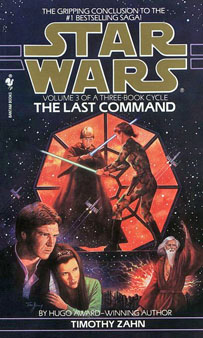“The Last Command” (1993) is a rich, rousing final chapter to Timothy Zahn’s Thrawn trilogy, but looking back on it through the lens of the prequels, it’s perhaps most notable for what the author doesn’t include. Although clones provide a major backdrop to the story, we don’t actually get to know any clones other than Dark Jedi Joruus C’baoth — and we see Luuke Skywalker, but he’s essentially a body operated by the extension of C’baoth’s will.
In retrospect, the fact that Zahn doesn’t let us into the clones’ heads allowed him to dodge a major continuity gaffe with the prequels, because a handful of lines of dialog in “The Last Command” suggest that the author’s vision is different from George Lucas’s. In the prequels, the clones have individual names and personalities, and this is emphasized even further in “The Clone Wars” (and Karen Traviss’s books, for that matter, even though those clash with “Clone Wars” in the portrayal of Mandalore). And, of course, there is a mutual respect between the Jedi and the clone troopers, whom the Jedi see as individuals whose lives are just as valuable as any non-clone soldier.
Zahn, on the other hand, makes several references in “The Last Command” to how horrible another round of Clone Wars would be, and his emphasis is on the “clones” rather than the “wars.”
Consider this exchange on page 153:
(Leia said,) “The Empire’s found some Spaarti cloning cylinders somewhere. They’ve been turning out huge numbers of clones to fight against us.”
Mara stared at her, an icy chill running through her. Clones … “No one told me,” she whispered.
Later, on page 229, Mara says: “The only reason I’m here is because I know a little about the Clone Wars era and I don’t want to see a bunch of cold-faced duplicates trying to overrun the galaxy again.”
As we now know, the clones were merely tools of the Empire (as Mara was, so although we don’t know her complete backstory yet, it’s possible she had a rivalry with the clone troopers), and they never independently tried to take over the galaxy. Those that did break free of the military went into hiding, we learn in Traviss’s books and in “The Clone Wars” Season 2 episode “The Deserter.”
As it stands, these are a few oddball lines of dialog that show Zahn was on the wrong path, but because he doesn’t delve fully into the details of the Clone Wars, it saves “The Last Command” from being apocryphal. Furthermore, some of the differences in Zahn’s and Lucas’s visions — for example, Luke senses a strange buzzing in his head when clones are nearby, and that’s certainly not an issue with Anakin or Obi-Wan — can be explained by the fact that Zahn’s are rapidly grown Spaarti clones and Lucas’s are more-meticulously grown Kamino clones. Essentially, Kamino clones are a superior product, so they have a humanity that’s lacking from the robot-like Spaarti clones.
As for the book at large, “The Last Command” cribs a bit from “Return of the Jedi” for its conclusion: A trek through a forest (Wayland), help from small-statured new allies (the Noghri), and a lightsaber duel in one of the Emperor’s throne rooms (Luke vs. Luuke) as Lando and Chewie attempt to blow up the whole Mount Tantiss storehouse. The conclusive space battle is a bit forced, I’d argue, because both the Republic and the smugglers are going after a piece of equipment that’s not needed anymore, as all of the cloaked asteroids around Coruscant had been accounted for. Zahn is a usually a master plotter, but things don’t jell perfectly here.

Although the ending is acceptably epic, the elements I remember more fondly are the search for the mysterious Delta Source in the Imperial Palace, Karrde’s clever outing of Niles Ferrier as the traitor in the allied smugglers’ midst, and the way Mara gradually realizes that the New Republic is indeed the good guys — not because they plead their case, but because she observes their actions and the values that drive those actions.
On this re-reading, I searched for hints of a Luke-Mara romance that I didn’t notice before, but I didn’t find any; both characters’ focus is elsewhere. I don’t know if Zahn always intended to get them together or if it struck him as a good idea only when it came time to write “Specter of the Past” (1997), the first book of the “Hand of Thrawn” duology. Ultimately, I am a fan of the Luke and Mara pairing, and it’s cool that it emerged so organically. (Some might argue that it’s obvious from the beginning, going by the theory that there’s a thin line between love and hate, and Mara had harbored a hatred for Luke before she even met him.)
Another thing I noticed on this re-reading of the Thrawn trilogy is that — although densely packed with characters, locations and plot threads — it is ultimately a straightforward, brisk read. It’s richer than the original movie trilogy not because it’s more complex, but rather because there’s just more stuff going on — Zahn uses the written-word medium as well as the films use the visual medium.
Next up, I think I’ll tackle the Thrawn trilogy comic book adaptation, which I remember as being confusing and choppy; maybe it’ll read better now that I have the events of the books fresh in my mind.
What are your thoughts on “The Last Command?” Share your comments below.

